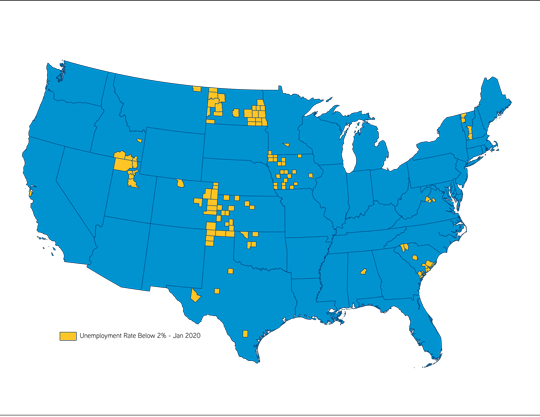Summary
A loyal workforce is the goal of every industrial business. Replacing workers can cost up to 6 months of wages and lost productivity.
High performing businesses have learned how to use design elements to engage and attract workers – especially in manufacturing and distribution.
Attracting and Retaining Employees isn’t a Jedi Mind Trick
As 2020 rolls along through the impacts of COVID-19, one of the legacies from the previous year that is not changing is “the force”, that is, the labor force, and industrial companies’ need for workers.
At an industrial conference in the Fall of 2019, the global director of real estate for a major manufacturer and distributor put it this way: their business struggles to identify locations with plentiful labor. They often are forced to occupy space in markets that do not have adequate labor resources.
Are these the workers you’re looking for?
Pre COVID-19, US unemployment stood at 3.6% and many markets across the US were stressed for workers. This reality was especially true in metro markets where labor resources were even more scarce. However, as unemployment claims skyrocket during the pandemic the demand for workers remains strong as industrial businesses continue to hire. The long-term question remains that even if a labor force can be identified and recruited, can you retain them?

Replacing workers can cost a business the equivalent of 2-6 months of wages due to recruiting and training costs, as well as loss of productivity. Identifying new workers, onboarding and training can churn time and resources.
Is your vision 20/20?
For the remainder of 2020 and beyond, we see three principles for industrial businesses to follow to attract and retain workers. None of them require you to be a Jedi Master:
- Make location decisions based on labor, not real estate. Too many companies look through the wrong end of the telescope when expanding their business. Instead of starting with a building search, identify the key characteristics for the short and long-term sustainability of the business. Labor force analytics are a great place to start, taking a deep dive into data and trends to identify communities which can supply the labor needed. Then and only then address the building.
- Retaining workforce takes a cultural change. Jeff Weiner, CEO of LinkedIn put it this way, “The three qualities of people I most enjoy working with are: Dream Big, Get Stuff Done, and Know How to Have Fun.” In the long run, today’s labor force has aspirations beyond earning wages to pay their bills. Employees want to know their contribution matters and they have a voice in the business. High performing industrial businesses are challenged to resonate with this mindset as they expand and grow into new markets. Consider how your business can foster a different kind of culture.
- Aesthetics impact the workforce. The nexus between employees and employer is the physical environment in which they work. Creating a workspace that is bright, colorful and engaging is not limited to just office or retail spaces. Design elements in manufacturing plants or distribution centers can make a difference in the bottom-line by improving worker retention and productivity.
For example, a top-25 retailer lowered turnover in their distribution center (DC) by 33% by addressing employee comfort; Kroger renovated a 400,000 square foot DC that now ranks in the top 25% of all of its facilities for trust and communication; and Publix is saving $250,000 a year by paying closer attention to employee experience in their warehouses. Coffee bars, basketball courts, discounted dining facilities, gyms and walking trails are among the new perks offered at many industrial employers to attract and retain workers. These amenities give employers a competitive edge in the recruiting wars and can be a fraction of total facility development cost.

Think Long-term…
Workforce transformation to attract and retain talent is happening all around the US in retail and office applications. Therefore, industrial employers must also transform their working environments to compete for the best long-term labor. As manufacturers and distributors embrace more technology and innovation, the workers staffing these facilities will continue to become more sophisticated. Long-term investments require a wholistic view and embracing a strategy to attract and retain workers is at the top of the list for 2020 and beyond.
Check out these case studies of how other industrial businesses have married location decisions of cost, labor and design simultaneously.

